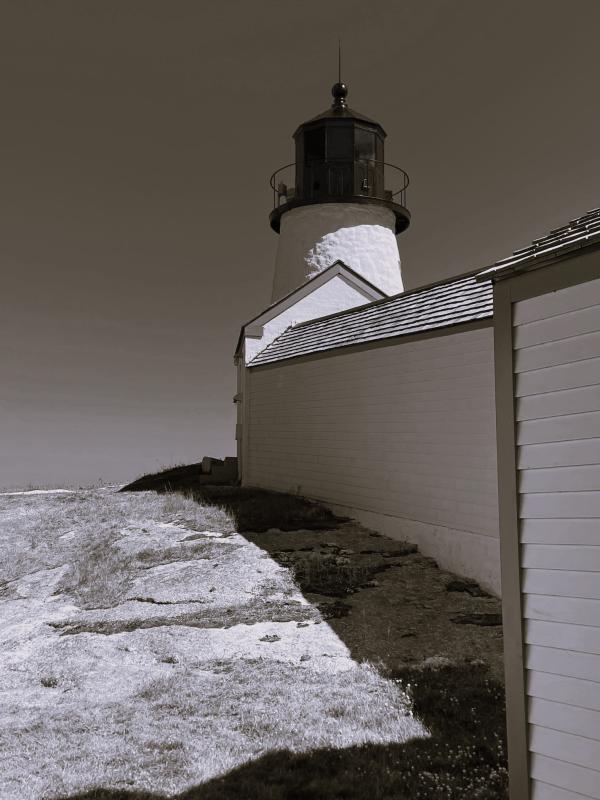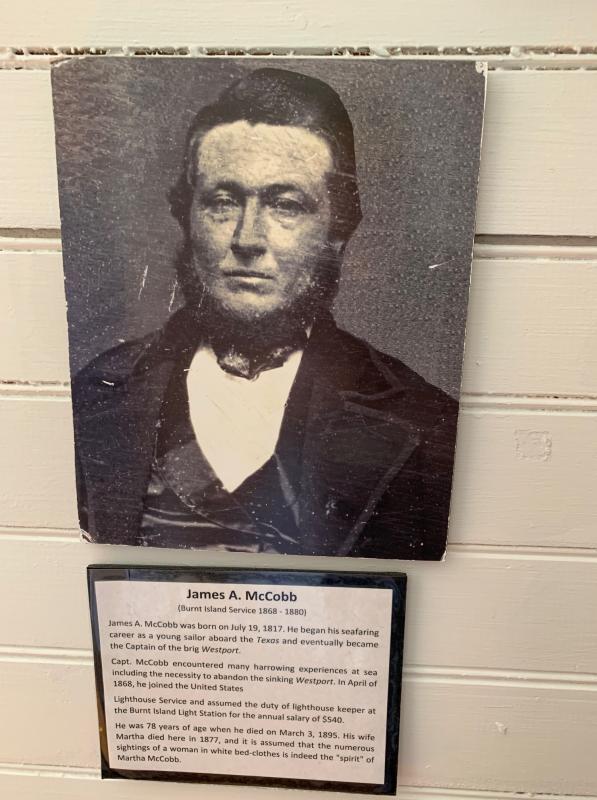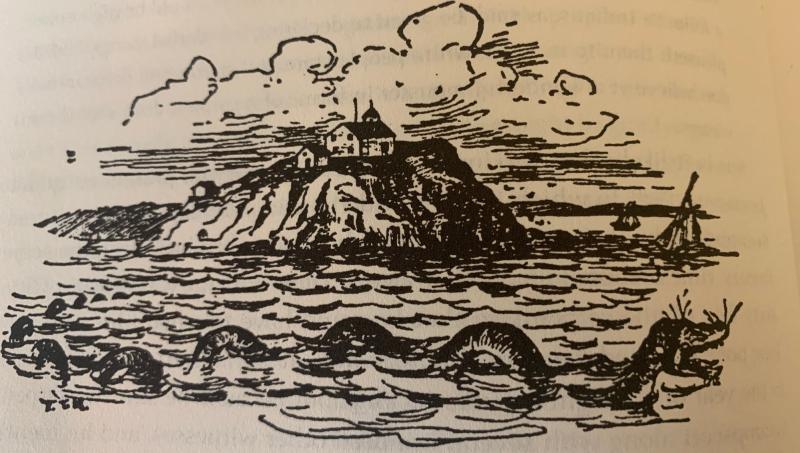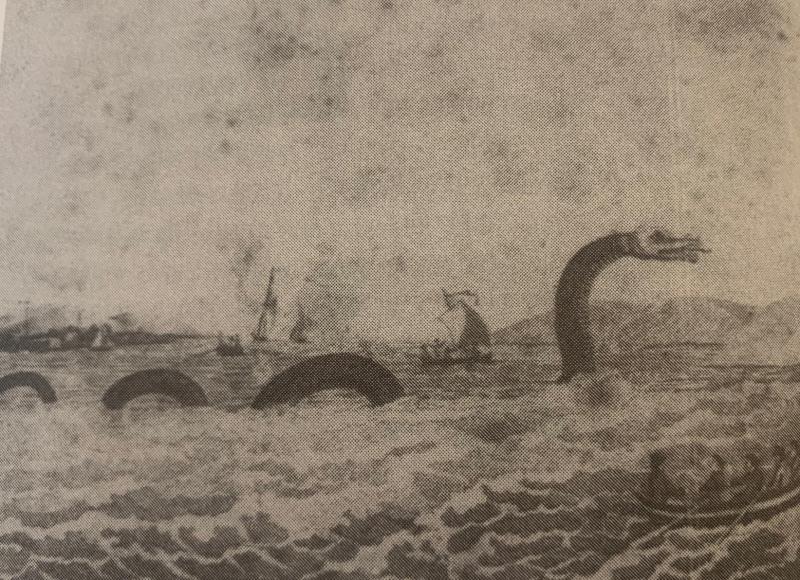There are places in this world that seem to have more than a fair share of mysterious happenings. The Scots refer to these locations as “thin places” where the veil between this world and the eternal world is thin. Thin places are said to be places of energy often experienced beyond the limits of our five senses. Sometimes in these thin places, we are lucky enough to see, hear, smell, and feel things that are not of this world.
The Celts also believed that during Samhain the division between this world and the otherworld was at its thinnest, allowing spirits to pass through. On Halloween, a mere whisp of spider web separates us from the next world. So tonight while you’re out trick-or-treating or watching Halloween or attending a party dressed like Michael Myers, keep your eyes, ears, and mind open. You just might experience something extraordinary. Have a happy and safe Halloween!
The history of Burnt Island Light begins in 1764 when Boothbay region merchants and mariners petitioned the British government for a lighthouse to help guide ships into the harbor. Their request was disregarded by the colonial authorities. The Revolutionary War and the War of 1812 put a damper on the local economy and any investments in lighthouses. It wasn’t until 1821 that the federal government appropriated funds for lighthouses and the 5-acre Burnt Island was purchased for $150 from a local businessman. It took only four months to construct the tower using granite quarried from the island. It stands 30 feet tall and has four-foot-thick walls. It was first lit in November of 1821 and is the oldest original lighthouse in Maine, built after Maine became a state in 1820.
Keeper James McCobb served at Burnt Island Light from 1868 to 1880. McCobb kept a very detailed logbook while stationed on the island. It was filled with entries about sea storms and sinking ships. He also wrote about his wife’s long illness and multiple doctor visits. On March 22, 1877, McCobb reported on Martha’s death:
“Wife died this morning about two o’clock of congestion of the lungs and cankers in the throat, stomach and bowels. She had been in feeble health all winter but able to be about the house attending to her work until about two weeks before her death when a cold brought on congestion and then canker which caused her death as above stated. She was carried off to the harbor and buried at the center burying ground in Boothbay on the following Sunday. Her age was fifty-three years and four months.”
Since Martha’s death, visitors on the island have reported seeing a woman in a white nightgown often in the early morning hours, around the time of Martha’s death.
Betty McCollough, the wife of keeper James McCollough, who served at the station from 1958 to 1961, saw the Lady in White one evening while waiting for James to return from a trip to town. She observed a woman dressed in white outside the front porch near a lilac bush. The ghostly figure moved around the bush before disappearing.
Hank Sieg was the last keeper to serve on Burnt Island. He and his wife Jeanne moved onto Burnt Island in 1983 and welcomed two children during their stay. They left in 1988 when the light was automated. I met Hank and his son on the island last year and he told me about the night he saw Martha’s ghost. He woke up in bed just in time to see a woman in white nightclothes walking down the hallway and going into another bedroom. Thinking this was his wife, he rolled over to get more comfortable and was startled to find Jeanne sound asleep next to him. He went into the other bedroom to investigate and found it to be empty and ice cold.
Another of the island’s ghosts is Ben Stockbridge who was the lighthouse keeper from 1951 to 1955. Ben developed some health issues, including a bad leg. The Coast Guard sent a younger man called Reg out to the island to help Ben with some of the more physical chores. Reg was inexperienced when it came to tending a lighthouse, so Ben took the young man under his wing, determined to teach him the correct way to do everything. Ben’s health finally declined to the point that he required hospital care. Reg took Ben and his wife ashore, helping the older man to the hospital before making his way back to the island.
Reg was now alone and a lighthouse keeper, in spite of his inexperience. He took on the job and was doing well until one morning around 2:00 a.m. (remember, this is also the time that Martha died) when his sleep was interrupted by his bedroom door slamming open and a voice shouting, “The light is out, the light is out! You have a smoke-out!” Reg glanced out his window and saw that indeed the light was out. He scrambled through the covered walkway and up the tower to relight the beacon. The next day, Reg went into Boothbay Harbor where he met a local fisherman. When Reg asked how Ben was doing in the hospital, the fisherman told him that Ben had died at 2 o’clock that morning.
Not long after Ben died, Reg had one more run-in with his ghost one night as he sat in the kitchen facing the door to the covered walkway. He heard a noise coming from the walkway. It grew louder and closer until Reg realized it was the sound of slowly approaching booted footsteps that sounded like Ben dragging his bum leg. Reg stood up quietly and grabbed a long length of string from the kitchen. Easing his way to the closed door to the covered walkway, he looped one end of the string through the finger latch on the door and tied it off. Facing the door with the string to the door latch in his left hand, he picked up his rifle in his right hand. He waited until the footsteps were right outside the door and yanked on the string, causing the door to swing open. It was apparent that there was no human trespasser in the hallway. Reg lay awake all night and decided that he had to go. The next morning, he cleaned and extinguished the light and draped the lens with a linen cloth then radioed the Coast Guard station on Damariscove Island and declared that he would not spend another night on Burnt Island.
To this day, people who work and sleep overnight on the island report their watches stopping at exactly 2:00 a.m. every night!
There are many historical reports in the form of newspaper stories and personal letters that tell of the sea serpents that used to grace this harbor every summer from the 1830s up through the 1890s. These reports coincide with other Great New England Sea Serpent reports from Massachusetts all the way up to Mount Desert Island in Penobscot Bay.
I was delighted to find that our local historical society has a folder full of these accounts. One is a letter written by a Boothbay Harbor citizen called Elizabeth Reed in April of 1867. In this letter, Elizabeth describes many visits to Burnt Island when Joseph Prescot Chandler was the first lighthouse keeper. Elizabeth would take her baby out to the island to spend time with Chandler’s wife, Hannah, and their two children. On one clear autumn day in 1830, Elizabeth arrived on the island for her last visit of the season. She found the family in a great state of excitement, and full of regret that she had not gone down the day before. Mr. Chandler had spotted a school of mackerel and had taken his wherry and gone fishing. During his absence, the two children aged three and five years old, went down to the island’s small cove beach to play. They returned suddenly. “Back they came, their eyes as big as saucers, screaming, Mother, Mother, there’s the biggest eel you’ve ever seen in your life, in the cove.” Hannah ran back down to the cove with the children and saw what she thought must be a giant snake because “it hadn’t sign of fin from head to tail” as an eel would have. It also seemed to be asleep because it did not move. He was so long that his head lay on one point of the cove while his tail touched the other – 30 feet and nothing less. Hannah and the children watched him for several minutes until the ebb tide made him touch the ground, and then he started and wiggled about until he got afloat, and swam off to sea, carrying his head above the water.
Following this incident, keeper Chandler also saw the sea serpent one evening two hours before sunset, creating a considerable wake left behind in the water. Mr. Chandler could distinctly make out two bunches on its back that were brownish in color. It returned to the little cove where his family had seen it earlier, coming so close to shore that Chandler could have hit it with a rock. There was no doubt that this monster was 100 feet in length so perhaps it was the mother of the smaller serpent his family saw in this same area. The sea serpent took an easterly course and passed very near some fishing boats anchored near the island. The crews informed Chandler that it was so close to them that one of them threw a potato hitting the serpent and believed it to be 150 feet in length.
If you’re into sea serpents (and who isn’t?!), I highly recommend reading J.P. O’Neill’s fantastic book, The Great New England Sea Serpent: An Account of Unknown Creatures Sighted by Many Respectable Persons Between 1638 and the Present Day (Paraview, 2003). And if you enjoy mysterious stories like the ones featured in the 13 Days of Halloween Tales of Terror, look for our Mysterious Harbor Electric Bike and Walking Tours starting in Spring 2024.


































